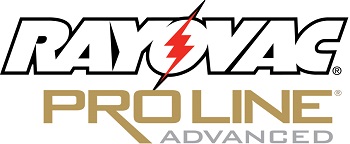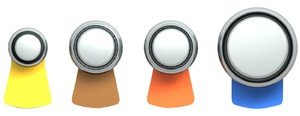Getting the Most from Hearing Aid Batteries: Expert Insight from Rayovac
Carolyn Smaka: Hearing aid batteries today don’t last as long today as they used to 5 or 10 years ago – why the difference?

Denis Carpenter: It’s due to the innovation in hearing aid technology; today’s hearing aids are essentially mini computers. They require significantly more power than the old analog hearing aids of years past. These computers analyze sound and make decisions and the processing is very sophisticated. Processing is measured in MIPS or million instructions per second. The more instructions that occur in that timeframe, the more power that is required to run the hearing aid.
Carolyn: Will you see the difference in drain on a hearing aid spec sheet if you compare one from today to an old analog device?
Denis: No - the measurement for battery drain in hearing aids hasn't changed; it’s based on how much current is required to amplify a pure tone sound.

Carolyn: I don’t know many patients using their hearing aids to listen to pure tones.
Denis: Exactly. So on the product data sheets you're seeing the same type of current draws today, even though real life current needs are very different. For example, take a hearing aid where the product data sheet says that the current drain is 1.5 milliamps. When the patient wears that hearing aid in background noise situations, the signal processing is going to kick in to high gear to utilize noise reduction, directional microphones, multichannel compression, feedback management and other features. In these situations, the current draw will increase substantially. And if you add in wireless audio streaming on top of that, you might see the current drain double or even triple what’s on the spec sheet.
So if you estimate battery life by looking at what’s on the data sheet you will be overestimating by quite a bit. For example, if the battery is rated at 150 milliamps, you divide by 1.5 and you’ll estimate 100 hours. However, in dynamic, real-life contexts much more current is required and the battery life will be less.
Carolyn: The features you mentioned that contribute to increased current drain – like noise reduction, feedback management, and automatic, adaptive, directional microphones – have proven benefit. And because they work automatically, patients may not even ‘know’ they are working.
Denis: That’s right. Other features that contribute to increased current drain include technology that communicates between the right and left hearing aids, as well as CROS technologies that stream data between devices.
In situations where these features are not active, there is less current drain. For example, take a week when you’re home and it’s quiet. You may watch television, and have one-on-one conversations with your spouse. Let’s say your hearing aid battery lasts the entire week. Then, the following week you attend a family reunion, have a lot of company, and attend a football game. Your battery life may be five days because of the change in your lifestyle and the demands on the hearing aid signal processing.

Jenna Rebout: As Denis mentioned, most hearing aid features today are automatic, so patients aren’t even aware they are working; this is great because they provide seamless hearing from one situation to the next. But, patients may be confused if they expect that their battery will always last a specific number of days, as it really depends on the environments they’re in and the demands on their hearing aid technology.
Carolyn: What do you recommend professionals tell their patients in terms of realistic expectations when it comes to battery life?
Jenna: It’s important for professionals to make patients aware of how the signal processing in the hearing aid may impact battery life. Rather than tell a patient a specific number of days that a battery will last, educate the patients on the features in their hearing aids. Explain that while these features interact to benefit them in different environments, they will impact current drain and battery life. Help them understand what is a realistic range for battery life, rather than specific number of days.
Denis: Battery life is going to be very individual; two patients using the same hearing aid won’t necessarily have the same battery life. It depends on the hearing aids’ settings, what features are active, how many hours a day they use the devices, and the environments that they are in. Obviously, a patient who wears hearing aids for 16 hours a day is not going to have the same battery life as one who only wears hearing aids for 8 hours a day. In addition, it’s very common that the batteries in a binaural set of hearing aids will last different amounts of time. That’s because if the loss is different between the ears, then the programming between the right and left aids are different. This impacts battery life. So there are many individual factors to consider.
When you first fit the hearing aids, tell the patient to track their battery life on the calendar, and mark the dates when they need to change batteries. They can do this for the first few months to get an idea of the average amount of time their batteries will last, based on all the individual factors we talked about.
If you overestimate from the start, and tell patients they will get about 7 days out of their hearing aid batteries, but they only get 5, for example, they will be unhappy.
Jenna: Good point, Denis. It’s important not to generalize and tell patients, “Most of my patients get ___ days from a battery”. Personalizing the experience and establishing what is average for each patient by having them track their battery life will result in happier patients.
Carolyn: It reminds me of gas mileage in a car. Just because two people drive the same car doesn’t mean a tank of gas will last a week for both people. It depends on how often you drive the car, how you drive the car, whether you are doing city driving versus highway driving, and other factors. Your car salesman can’t tell you, “A tank of gas will last one week”.
Jenna: Right, that’s a good analogy.
Carolyn: Hearing aid technology has certainly changed through the years, and battery technology has changed along with that. How has Rayovac battery technology kept up with the hearing aid technology?
Denis: Due to innovations in battery technology, today’s hearing aid batteries from Rayovac have twice as much energy as the zinc air batteries we manufactured in the 80s and 90s. That energy is what enables all the new hearing aid features and technology to run today.
Carolyn: You couldn't take a battery from back then and put it in a wireless ITE today?
Denis: No, it wouldn’t work.
Over the years, we’ve improved the ability to deliver current and we also added energy. On the flip side, if you took a Rayovac battery from today and used it in an old analog hearing aid from the 1980s, you would get double the battery life than you would have back then with an old battery. In the 80s if your battery lasted 7 days in your analog aid, a battery from today in that same aid would last 14 days or more.
In analog hearing aids, the devices essentially ran a constant current all the time. With digital processing, that extra life we’ve built into our batteries is used by all the new processing. If you take a size ten battery today, typical life might be about 5 days. But what that size ten can do in terms of powering today’s technology is pretty amazing.
In addition to these changes, we have also converted to a zero mercury system where we have no mercury added to our batteries for environmental reasons. Mercury is a toxic chemical but from a battery standpoint it was a very good gas suppressant. Removing the mercury took a lot of R & D from our side, as well as changes to the manufacturing process.
Carolyn: I have a few “Frequently Asked Questions” that we get about batteries. The first is, how long should you wait after taking the tab off a battery before inserting it into a hearing aid?
Jenna: That is a very common question we get about zinc air batteries. We recommend about 1 minute. It's enough time to let air get into the battery to help activate it. I've heard that people take the tab off and wait anywhere from five minutes, to a couple hours, to let it sit overnight, but really only about a minute is needed.

Rayovac family of hearing aid batteries.
Denis: Waiting a full minute ensures a good start condition for the battery. People think that waiting a full minute for the battery to power up means they will get longer life from the battery. That's not really true.
Think about turning on your computer. You have to wait for it to boot up before you start using it. The same thing actually occurs with a hearing aid. A hearing aid has a boot up sequence and it requires a lot of power. So you want to ensure your hearing aid battery has the voltage to power that start up sequence. Allowing the battery to wait for one minute after it’s untabbed before inserting it into the aid will ensure it has the voltage it needs to support the start up sequence.
Carolyn: Next FAQ. How can I maximize battery life in my hearing aid?
Denis: We hear that question frequently, as well as, “How can I make my hearing aid battery last 7 days?”. That seems to be a magic number for people, as it keeps it simple to remember to change your battery once per week on the same day.
Turning your hearing aids off and opening the battery doors when you’re not using them is the best advice. Always buy fresh batteries, and store them in a cool, dry location. Don’t keep them in your glove compartment, in the refrigerator, on your radiator, or anywhere they’ll be exposed to temperature extremes. Keep them in the original packaging and obviously, don’t remove the tabs until ready to use.
Carolyn: Denis and Jenna, thanks for all the info. It’s been a pleasure catching up. For more information, please visit the Rayovac Expo Page on AudiologyOnline, or www.thepowerofhearing.com



